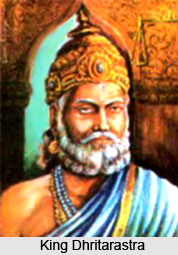 The parable of the man in the well is one of the many parables in the Mahabharata, aimed at imparting a moral lesson to the people. Great fame and almost universal propagation has been attained by the parable of the Man in the well which the wise Vidura relates to King Dhritarashtra. The main story of the Man in the Well is recounted below.
The parable of the man in the well is one of the many parables in the Mahabharata, aimed at imparting a moral lesson to the people. Great fame and almost universal propagation has been attained by the parable of the Man in the well which the wise Vidura relates to King Dhritarashtra. The main story of the Man in the Well is recounted below.
A Brahmin loses his way in a dense forest full of beasts. In great terror he runs here and there, looking in vain for a way out. Then he sees that the terrible forest is surrounded on all sides by traps and is embraced by both arms of a dreadful-looking woman. The great forest is surrounded by terrible five-headed dragons, which reach up like rocks to the sky. Right in the middle of the forest, covered by underwood and creeping plants, there is a well.
The Brahmin falls into it and is caught on the intertwined branches of a creeper. It is said in the epic, "As the great fruit of a bread-fruit tree, held by its stalk, hangs down, so he hung there, feet upwards, head downwards." As terrible as his situation was, another bigger and greater danger threatens the Brahmin. In the middle of the well he perceived a great, mighty dragon, and at the edge of the lid of the well he saw a black, six-mouthed and twelve-footed giant elephant slowly approaching. In the branches of the tree which covered the well swarmed all kinds of dreadful bees, preparing honey. The honey drips down and is greedily drunk by the man hanging in the well. Despite this predicament, he did not give up his hope for life, even though white and black mice gnawed the tree on which he hung.
The forest, as Vidura explains the metaphor to the king, is the Samsara, existence in the world; the beasts of prey are the diseases, the hideous giantess is old age, the well is the body of beings, the dragon in the bottom of the well is time, the creepers in which the man was caught, the hope of life, the, six-mouthed and twelve-footed elephant, the year with six seasons and twelve months; the mice are the days and nights, and the drops of honey are sensual enjoyments.
There can be no doubt that this parable is a genuine Indian version of ascetic poetry. Even though has been called "originally Buddhistic," it does not correspond more with the Buddhists` view of life than with that of the Jainas and of other Indian ascetic sects. As with this parable, so with many moral narratives of the Mahabharata, one might be inclined to trace them back to Buddhistic sources. On closer scrutiny, however, they could equally well have been drawn from that source of popular narratives which was alike at the disposal of Brahmins, Buddhists and other sects.












